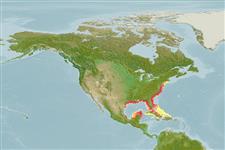Preferred temperature (Ref.
115969): 22.9 - 26.8, mean 24.1 (based on 132 cells).
Phylogenetic diversity index (Ref.
82804): PD
50 = 0.5000 [Uniqueness, from 0.5 = low to 2.0 = high].
Bayesian length-weight: a=0.00794 (0.00647 - 0.00975), b=3.02 (2.98 - 3.06), in cm Total Length, based on LWR estimates for this species (Ref.
93245).
Trophic level (Ref.
69278): 4.5 ±0.5 se; based on diet studies.
Resilience (Ref.
120179): Medium, minimum population doubling time 1.4 - 4.4 years (K=0.2-0.38; tm=2-3; Fec=280,000).
Prior r = 0.68, 95% CL = 0.45 - 1.02, Based on 2 stock assessments.
Fishing Vulnerability (Ref.
59153): Moderate vulnerability (39 of 100).
Climate Vulnerability (Ref.
125649): High vulnerability (63 of 100).
